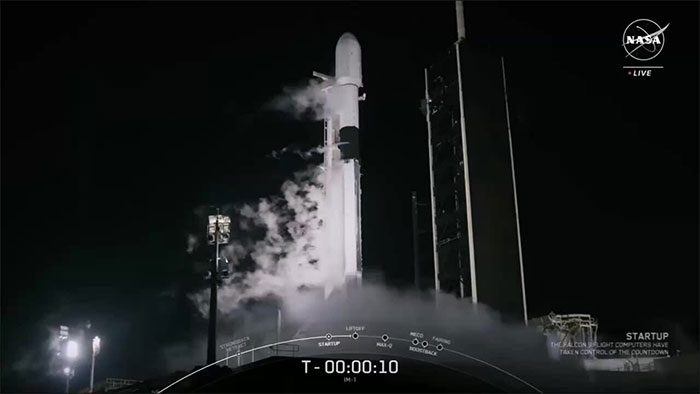The lunar lander Odysseus, or Odie, launched on a SpaceX Falcon 9 rocket from the Kennedy Space Center in Florida at 1:05 PM yesterday (Hanoi time).
The SpaceX rocket launches the lunar lander Odysseus into space. (Video: NASA/SpaceX)
The Odysseus lander is manufactured by Intuitive Machines, a Houston-based company in the USA. If everything goes according to plan, the spacecraft is set to land near the lunar south pole on February 22, becoming the first successful private spacecraft to land on this celestial body. This achievement would also be significant for the United States, a country that has not returned to the Moon’s surface since NASA’s Apollo 17 mission over half a century ago.
About 7.5 minutes after the launch, the first stage of the Falcon 9 rocket returned to Earth, landing vertically at Cape Canaveral Space Force Station in Florida. This marks the 18th launch and landing of this reusable rocket stage.
The lander weighs 675 kg, roughly equivalent to a British telephone booth. The spacecraft is now heading to a lunar orbit, a journey expected to take about a week. After that, Odysseus will prepare for its historic landing attempt, which is planned to land at Malapert A, a small crater approximately 300 km from the lunar south pole.

If all goes well, the spacecraft will land near the lunar south pole on February 22.
NASA will closely monitor the landing because Odysseus carries several instruments from the agency. NASA has “booked” space on the lander through the Commercial Lunar Payload Services (CLPS) program, which aims to leverage the capabilities of private American landers to deliver scientific equipment to the Moon in a more cost-effective manner.
These instruments are designed to collect data supporting NASA’s Artemis program. The Artemis goal is to establish a human outpost near the lunar south pole by the late 2020s. This region is believed to contain significant amounts of water ice, which could support astronauts on the Moon’s surface. Water ice could also be used to produce propellant, enabling refueling for spacecraft that have departed from Earth.
Odysseus carries six NASA instruments, including a suite of scientific devices designed to test new technologies or assess the lunar environment, such as analyzing soil and rock during the landing process. The spacecraft also carries various mementos, including a sculpture depicting the lunar phases, and technology from private companies, including Columbia Sportswear, which developed thermal insulation materials for the lander.
If all goes according to plan, Odysseus will operate for seven days on the Moon. However, as the landing area gradually shifts into the Earth’s shadow, the spacecraft will be placed in sleep mode during the lunar night.


















































